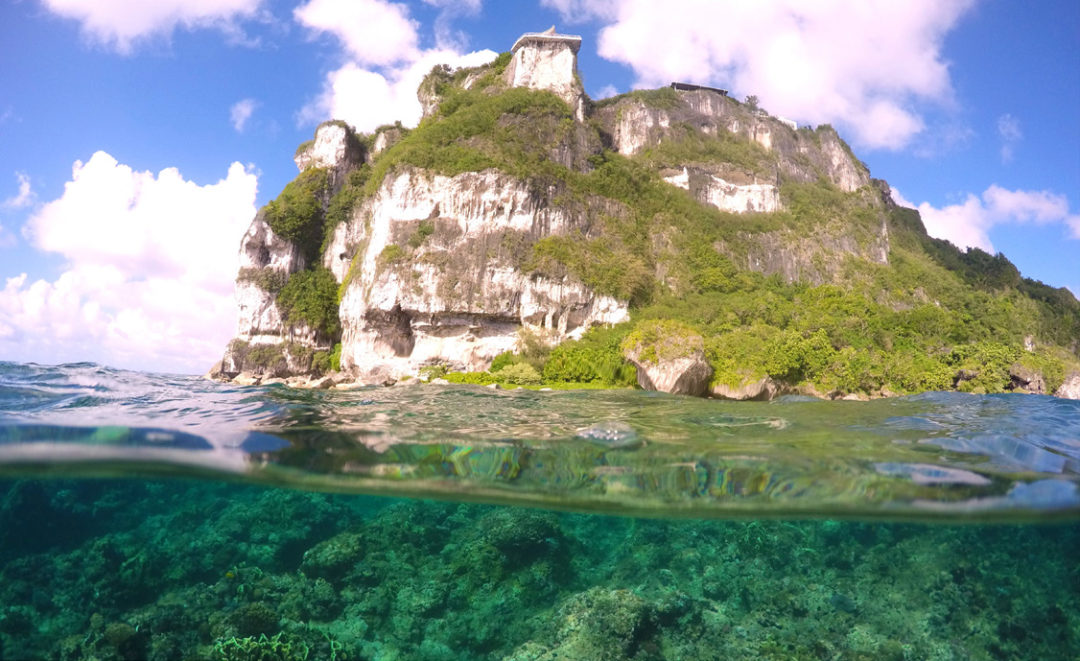Where We Work
The waters of Guam are home to 5,000 species of marine organisms, many of which rely on healthy coral reefs for survival. In Guam’s nearshore waters, the combined area of coral reef and lagoon is approximately 26 square miles—nearly 13,000 American football fields. Guam’s coral reefs are estimated to be worth $127 million per year, making them crucial to the economic, cultural, political and social viability of Guam.
Our Approach
Partnership efforts focus on providing technical support and capacity building for local staff to conduct watershed planning and prioritization of coral reef management efforts; increase effectiveness of monitoring efforts; and support local NGO advisory group development. To amplify conservation momentum in the region and foster shared learning, the partnership also supports regional learning exchanges and activities conducted within the framework of the Micronesia Challenge, a commitment to conserve at least 30 percent of nearshore marine resources and 20 percent of terrestrial resources by 2020.


Our Accomplishments
Partnership efforts have directly benefited approximately 87 square miles of coral reef habitat, provided 2 sites with technical support and resulted in the training of at least 50 people.
- Completed and formally adopted Conservation Action Plans (CAPs) at two sites (Cetti Bay and Manell-Geus Watershed). Plans resulted in increased community awareness and restoration efforts in the upper watersheds, including invasive species removal efforts targeting bamboo and invasive algae on the reefs.
- Trained 30 government resource managers to communicate the potential impacts of climate change to facilitate action by local agencies and stakeholders and reduce Guam’s vulnerability to climate change and other threats.
- Trained nine resource managers in effective project development and team management to improve execution of coral conservation work throughout Guam.
- Held a learning exchange for fishers from Guam to learn about alternative management approaches being used successfully across the Micronesia region. As a result, two attending fishermen went on to establish the Humåtak Community Foundation, a community-based conservation organization.
- Supported the enhanced capacity of local nongovernmental organizations through facilitation and completion of a needs assessment, strategic planning development and support for the Humåtak Community Foundation.
- Five Guam youth attended a learning exchange in Palau to increase awareness and understanding of community-based resource management.
We’re celebrating what we have and working toward conserving for our kids and our kids’ kids.

SUCCESS STORY: Humåtak Community Foundation
Jesse and Joe Quinata are brothers who grew up in Umatac, Guam on land that has been in their family for generations. They have fished their whole lives and have seen the ocean in Guam change. When the brothers go fishing, they catch only about two fish in four hours—much less than the old days. “People don’t use the same practices,” Jesse explains, “or fish for the same reasons. Fishing in Guam is now economic.”
Inspiration from a learning exchange
To learn what might be done to improve fishing practices and restore fish populations in Guam, Jesse and Joe attended a learning exchange in Palau supported by the Partnership. There, the brothers had the opportunity to visit one of Palau’s many marine conservation areas. Bobbing offshore in a small fishing boat, the group spoke about conservation as they caught one fish after another. A Palauan host explained, “The real fisherman is not the fisherman who catches a lot of fish. It’s the fisherman who understands the seasonal changes, the ethics of conservation and the whole process about fishing.” Joe reflects on how fishing in Palau feels different: “In Palau, fishermen value traditional ways. They’ve been conserving fish for years, and because of that they have plenty.”
Inspired by Palau’s abundance and approach to resource management, Jesse and Joe established a conservation organization for their village—The Humåtak Community Foundation. The Foundation promotes land and water conservation as part of the community’s cultural heritage..
“We’re celebrating what we have and working toward conserving for our kids and our kids’ kids,” Joe says. He points toward a lone fisherman standing knee-deep in the bay where the brothers grew up, “I want to be able to have my kids do what that man’s doing…fishing,” he continues.
A vision of a better forever
Since attending the learning exchange in 2011, Jesse and Joe have continued building the Foundation to promote their vision of a better forever—Nihi ya ta na’ maolek mo’na para famagu’on-ta, as they say. The Foundation has implemented various projects and programs to support marine conservation in Guam, such as the Umatac Coral Reef Ambassadors movement, which blends traditional beliefs with environmental values and provides the community with life-long learning experiences to promote awareness, teamwork and a future-focused mindset. They’ve also created the Humåtak Tree Planting Legacy Program which protects the health of marine ecosystems by mitigating land-based pollution and focuses on maintaining the balance between current needs for natural and cultural resources and the obligation of sustaining resources for future generations.
But they’re not stopping there, Jesse and Joe have even larger ideas. They plan to open the Humåtak Heritage-Based Community Charter School, “the school without walls,” as Joe calls it. Here, science will be learned at the mountain ridges, riverbeds and coastal reefs instead of in classrooms. Students will learn skills necessary to become contributing citizens, life-long learners and perhaps the next generation of conservationists.

